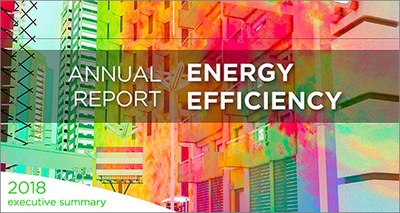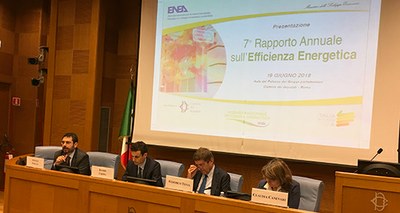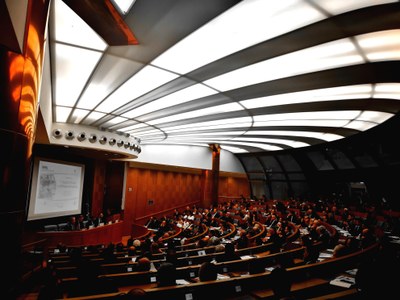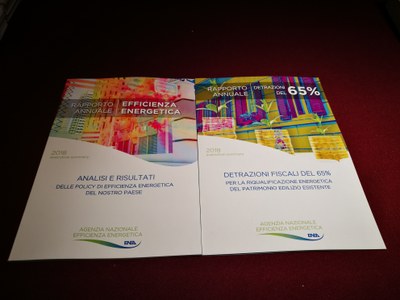ENEA's 2017 Annual Report on Energy Efficiency and investments representing 3,7 billion (so-called ecobonus)
5/7/2018
 Thanks to the so-called ecobonus, Italian families have invested over 3.7 billion euro in 2017 achieving about 420 thousand energy requalification measures, saving over 1,300 GWh / year. Furthermore, about 2 million tons of oil equivalent (Mtep) was saved from the emission of 5.8 million Energy Savings Certificates, the so-called White Certificates, of which 62% in the industry and 31% in the civil sector.
Thanks to the so-called ecobonus, Italian families have invested over 3.7 billion euro in 2017 achieving about 420 thousand energy requalification measures, saving over 1,300 GWh / year. Furthermore, about 2 million tons of oil equivalent (Mtep) was saved from the emission of 5.8 million Energy Savings Certificates, the so-called White Certificates, of which 62% in the industry and 31% in the civil sector.
This report is based on the ENEA 7th Energy Efficiency Annual Report presented in Rome, which also highlighted how all the measures taken in the efficiency sector from 2011 to 2017 have generated overall energy savings for 8 Mtoe final energy per year, equal to two and a half billion euros saved for lower natural gas and oil imports and about 19 million tons of CO2 less released into the atmosphere. These savings are equivalent to 52% of the target for 2020 envisaged by the National Action Plan for Energy Efficiency (PAEE) and the National Energy Strategy (SEN) and derive for about 37% from the White Certificates and for over a quarter of tax deductions for energy efficiency measures.
 The residential sector has substantially achieved the target set in 2020, the industry has half achieved the goals set, while the transport and service sectors still lag behind; the PA which is in the service sector was funded with 62 million euro for measures to improve structural efficiency through the "Thermal Account ". Furthermore, following EU regulations on energy requalification by 3% in relation to the surface area of the central agency for PA property, in 2014-2017, over 190 properties were completed or planned, for a gross usable area of about 1,9 million m2."
The residential sector has substantially achieved the target set in 2020, the industry has half achieved the goals set, while the transport and service sectors still lag behind; the PA which is in the service sector was funded with 62 million euro for measures to improve structural efficiency through the "Thermal Account ". Furthermore, following EU regulations on energy requalification by 3% in relation to the surface area of the central agency for PA property, in 2014-2017, over 190 properties were completed or planned, for a gross usable area of about 1,9 million m2."
According to ENEA president, Mr. Federico Testa, new measures, structural measures and simplifications will make it possible to achieve positive results for safe and energy efficient buildings, overcoming obstacles and problems". Testa also stated that specifically, the so-called ecobonus and “sisma” (earthquake) bonus pave the way for incentives in favor of the economically vulnerable population, about one in ten citizens, who often live in suburban condominiums of large cities that are not energy efficient". "ENEA has already set up a series of training and information actions to provide support on a national scale to technicians, administrators and decision makers. He further highlighted that thanks to the support of some large operators in the energy services market, redeveloping huge residential complexes and public buildings can be stepped up". To conclude, he said that "these efficiency measures have considerable economic and social repercussions with evident results in the fight against energy poverty, which affects millions of families in Italy and Europe".
 The ENEA Report on tax deductions was presented for the energy requalification of the existing building stock, illustrating the investments stimulated by the ecobonus. In 2014-2017, the energy redevelopment projects entailed average savings on consumers' annual bill between 250 euros in 2014 and 150 euros in 2017, also due to the different gas prices. In fact, these projects are equivalent to average annual savings of 15% on the total energy expenditure per household.
The ENEA Report on tax deductions was presented for the energy requalification of the existing building stock, illustrating the investments stimulated by the ecobonus. In 2014-2017, the energy redevelopment projects entailed average savings on consumers' annual bill between 250 euros in 2014 and 150 euros in 2017, also due to the different gas prices. In fact, these projects are equivalent to average annual savings of 15% on the total energy expenditure per household.
Since the ecobonus was launched, over 3.3 million operations were achieved in 2007, of which approximately 1.5 million in the period 2014-2017. The highest share in the last four years, amounting to over 6 billion euros, involved replacing 2.6 million window and door frames, while 2.1 billion euros were allocated to around 70 thousand operations on horizontal and inclined walls. Saving over 1,300 GWh / year for the projects performed in 2017 alone has been achieved mainly thanks to two categories that have the best cost / effectiveness ratio, namely replacing windows (about 40% of savings) and insulation of floors and walls (over 25%).
 Approximately 80% of investments in 2017 (€ 2.9 billion euro over 3.7 overall) concern buildings built before the 1980s. In particular, about 25% of total resources (over 920 million euro) was allocated to buildings built in the 1960s. Approximately 40% of investments (over 1.4 billion euro) concerned an isolated building (single or multi-family homes), while about 35% of resources (about 1.3 billion euro) involved projects on terraced buildings and over three floor condominiums.
Approximately 80% of investments in 2017 (€ 2.9 billion euro over 3.7 overall) concern buildings built before the 1980s. In particular, about 25% of total resources (over 920 million euro) was allocated to buildings built in the 1960s. Approximately 40% of investments (over 1.4 billion euro) concerned an isolated building (single or multi-family homes), while about 35% of resources (about 1.3 billion euro) involved projects on terraced buildings and over three floor condominiums.
One of ENEA's main activities in 2017 to promote energy efficiency at national level was the Class A Italy training and information campaign, in its second year, which organized a roadshow for families, PAs, trade associations and SMEs in ten cities from the north to the south of Italy, counting 10 million contacts through social networks.
After the presentation to the Chamber of Deputies, the ENEA’s Report will also be introduced at the Brussels European Parliament on 10 July.
